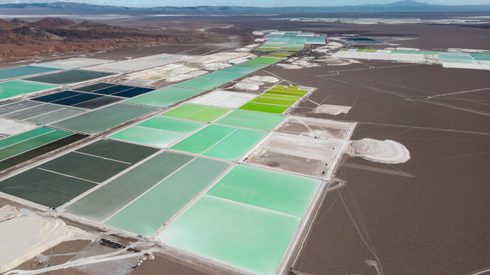- Buyer caution, weak demand further depress lithium prices prices in China
- Seaborne East Asian lithium prices flat amid thin trading
- European market quiet, watching developments in Asia.
Chinese market participants have reported limited spot trading over the past week, saying that buying appetite among downstream consumers was weak and that sentiment remained bearish for the short term.
Fastmarkets’ assessment of the lithium carbonate, 99.5% Li2CO3 min, battery grade, spot price range, exw domestic China, was 570,000-585,000 yuan ($80,261-82,373) per tonne on Thursday, narrowing downward by 5,000 yuan per tonne from 570,000-590,000 yuan per tonne a week earlier.
The assessment of the lithium hydroxide monohydrate, LiOH.H2O 56.5% LiOH min, battery grade, spot price range, exw domestic China, was 570,000-580,000 yuan per tonne on Thursday, narrowing downward by 30,000 yuan per tonne from 570,000-610,000 yuan per tonne a week earlier.
“The spot market was quiet,” a Chinese lithium producer source said. “Buyers were very cautious recently and have not been placing orders, especially with lithium prices on a downtrend. We have not received many inquiries over the past week.”
Market participants were pessimistic about the outlook for lithium demand in the near term and expected weaker lithium prices, especially during the first quarter of 2023. This was because they expected electric vehicle (EV) demand to be affected by the end of Chinese subsidies in 2023.
This further fuelled the caution among lithium consumers, market participants said.
Meanwhile, market participants continued to speak of production cuts among downstream battery producers in China over the past week, which contributed to the decrease in demand for lithium salts, they said.
“In addition, it’s the end of the year. While EV producers have met their annual [production] targets, they have slowed their production, which further cuts the demand for lithium salts,” a Chinese battery materials producer source said.
“It may not be until later this month that the spot market will become a little more active, when cathode and battery makers start to restock for their production during the Chinese [Lunar] New Year holiday in late January,” he added.
Meanwhile, China’s lithium carbonate supply had experienced interruptions recently, due to Covid-19-related controls in Qinghai province, the brine production hub in China.
“Due to Covid-19 controls in Qinghai, very few truck drivers are willing to enter the province, because they could be quarantined when entering another city,” a second Chinese lithium producer source said. “As a result, delivery of our orders to domestic customers is delayed by 10 days. Now, delivery takes about 15 days.”
These disruptions to lithium carbonate supply gave no support to prices amid the low demand, Fastmarkets has learnt.
Seaborne East Asian market flat
Spot lithium prices in the seaborne East Asian market were steady over the past week, with market participants citing limited trading, while the recent weakness in the domestic Chinese market had not filtered through.
“It is the end of the year. Traditionally, [South] Korean companies reduce spot purchases or any cash flow, and destock to show a better financial performance in annual reports. So spot buying of lithium salts has been rare,” a South Korean consumer source told Fastmarkets.
“Because Japan and Korea are entering the Christmas holiday season soon,” a third Chinese lithium producer source added, “and afterwards China enters its New Year holiday, the seaborne East Asian market will remain quiet until the Lunar New Year holiday is over.”
But although lithium prices in the domestic Chinese market have gone down in recent weeks, such weakness has not filtered through to the seaborne East Asian market, participants said.
“It may take another two weeks for the seaborne East Asian market to respond to the Chinese weakness,” the Chinese battery materials producer source said.
Fastmarkets’ daily price assessment for lithium hydroxide monohydrate, LiOH.H2O 56.5% LiOH min, battery grade, spot price, cif China, Japan & Korea, was $84-86 per kg on Thursday, unchanged since November 22.
The corresponding daily price assessment for lithium carbonate, 99.5% Li2CO3 min, battery grade, spot prices, cif China, Japan & Korea, was $80-82 per kg on Thursday, unchanged since November 8.
European market watches developments in China
Technical and battery grade lithium prices remained steady in Europe this week, with market participants noting a quiet spot market and many of them watching developments in the Chinese domestic market to see whether these will affect international prices.
Market participants told Fastmarkets that battery-grade prices remained at parity to seaborne China prices, with Europe needing to compete with China to attract units.
“It’s easier to sell into Asia, and we’ll be pushing up the European figures,” one market participant in Europe said.
Fastmarkets assessed the lithium hydroxide monohydrate LiOH.H2O 56.5% LiOH min, battery grade, spot price, ddp Europe and US, at $84-86 per kg on Thursday, flat week on week.
The lithium carbonate 99.5% Li2CO3 min, battery grade, spot price, ddp Europe and US, was assessed at $80-82 per kg on Thursday, also unchanged from a week before.
Market participants also said that the market was relatively quiet, with forward business for early next year more in focus.
Prices for technical grades of material were steady as well.
The lithium hydroxide monohydrate LiOH.H2O 56.5% LiOH min, technical and industrial grades, spot price, ddp Europe and US, was assessed at $77-80 per kg on December 1, unchanged over the week.
And the lithium carbonate 99% Li2CO3 min, technical and industrial grades, spot price, ddp Europe and US, was assessed at $70.00-76.50 on Thursday, also unchanged compared with the previous Thursday.
Visit our dedicated battery materials page to discover more insights on the factors at play in the industry in 2022 and beyond.





